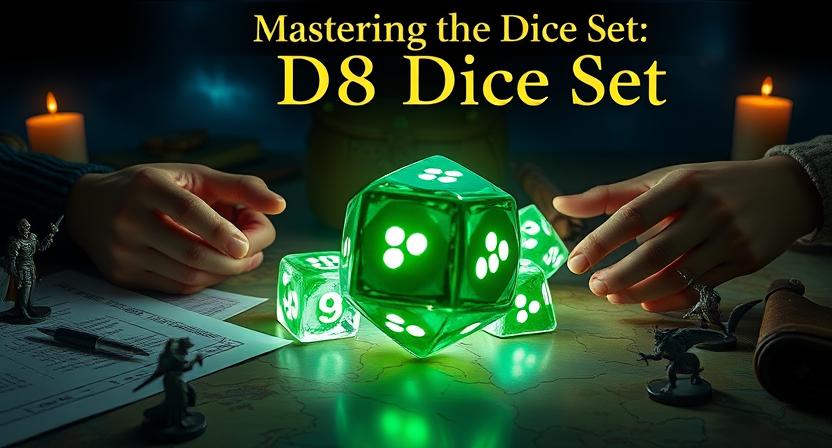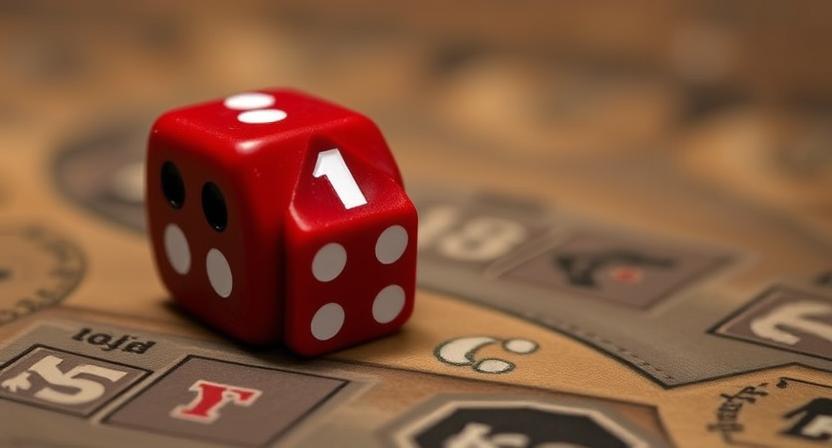Why D8 Dice Sets Matter
The d8 dice set is more than just a tool for rolling numbers, it’s a gateway into ancient traditions, immersive gaming experiences, and artistic craftsmanship. The eight-sided die has played an extraordinary role from heritage-rich societies like Rome, Egypt, India, and China to modern tabletop games and RPGs. This guide explores every angle of the d8 dice, offering insight into its structure, uses, and the excitement it brings to millions around the world.

Understanding the Origins of Dice
Dice are not just modern gaming instruments. They have existed for thousands of years, originally carved from stone, wood, and even bones, often found in museums. Ancient cultures used dice for divination, tax collection, and even detecting fraud. These objects reflect an homage to early societies’ fascination with chance, fate, and mathematical structure.
The d8 specifically finds its roots in early polyhedral systems, where shapes like the octahedron were understood for their geometric balance and fairness in rolling. Today’s premium sets are a refined version of this historical marvel.
Anatomy of a D8 Dice
At its core, the d8 dice is a truncated octahedron or a regular octahedron, giving it eight large, triangular faces. This makes it both visually distinctive and mathematically fair for random rolls.
While traditional dice like the d6 (six-sided) dominate casual board games, the d8 is a favored tool in many RPGs, thanks to its ability to provide middle-of-the-road values. Its shape ensures it rolls smoothly and stops cleanly, reducing the chance of bad landings or ambiguous results.
You may also come across shapes such as octagonal prisms or pipe-sided designs marketed as novelties, but these lack the balanced rolling behavior of true octahedrons.
Polyhedral Dice and the D8’s Place Within
A standard polyhedral dice set typically includes several different dice: a four-sided die (d4), six-sided die (d6), eight-sided die (d8), ten-sided die (d10), twelve-sided die (d12), and twenty-sided die (d20). Each serves a unique function. The d8 dice set is often regarded as the middle child, providing values higher than a d6, but not as chaotic as a d20.
Gamers often prefer the d8 when they want predictable variability enough to keep things interesting, but not enough to introduce wild swings in gameplay. It’s a well-balanced die with a 12.5% chance for each face.
Game Mechanics: How the D8 Works
Understanding how to roll dice numbers is crucial in any game. The d8, like others, is rolled until it comes to a stop, with the top-facing side being the result. It’s important to note that the average roll of a single d8 is 4.5, meaning players can plan strategy around this value.
In many tabletop RPGs, you’ll see notations like 1d8, 2d8, or even 8d8. The letter “d” stands for “die,” and the number before it tells how many to roll, while the number after refers to the die’s sides. For example:
- 1d8 = Roll one eight-sided die.
- 2d8 = Roll two d8s and add the results.
- 8d8 = Roll eight d8s, often used for massive spells or attacks.
This system is detailed in most player handbooks, especially for games like Dungeons & Dragons (D&D).

The D8 in Action
Weapons and Damage Rolls
In many RPGs, the d8 is used to calculate weapon damage. Weapons like the battleaxe, rapier, and longsword commonly use 1d8 for damage. This gives characters a nice balance between precision and power, without the outrageous spikes seen in d12 or d20 damage rolls.
Hit Dice and Health Calculations
Another integral use of the d8 is for Hit Dice Rolls. When creating or leveling up a character, classes like the cleric, rogue, or bard often use a d8 to calculate maximum HP or healing after rest. This makes the d8 a vital component in combat, recovery, and exploration strategies.
The D8’s Role in Casting
Some of the most iconic spells in RPGs use multiple d8s for their effects. For example:
- Chain Lightning or Finger of Death might call for 8d8 rolls.
- Wall of Fire may rely on 2d8 damage per round.
- Cure Wounds might involve 1d8 + spellcasting modifier.
These spells show how the d8 balances damage and healing, providing high variability without overwhelming outcomes.
D8 Dice Set for Sale: What to Look For
When shopping for a D8 dice set for sale, there are a few things to consider:
- Materials: Wood, stone, acrylic, metal, and even resin options are available. Some prefer handsome wooden sets, while others lean toward the heft and feel of metal.
- Design: Look for visually distinctive fonts and color contrasts that make numbers easy to read.
- Balance: Premium dice are molded evenly to ensure fair rolls. Cheap or unbalanced dice may result in bad landing squares.
- Purpose: Are you buying for gaming, collection, or gift-giving? This determines the kind of packaging, extras, and quality you’ll want.
Best Options for D8 Dice Sets
Amazon: Reliable and Varied
Searching for a d8 dice set on Amazon opens a world of choices—from affordable bundles to collector-grade polyhedral dice sets. Amazon often features trusted brands and customer reviews, which can help you pick based on quality, material, and aesthetics.
Dice Envy Alternatives
Sites like Dice Envy offer stylish, limited-edition dice, but if you’re looking for alternatives, check out independent Etsy sellers, Kickstarter-backed brands, or niche gaming stores. These places often sell sets that cater to more specific tastes, like octahedral crystals or themed collections.
Using a D8 Dice Roller Online
If you’re in a pinch and don’t have physical dice, an online d8 dice roller is a great tool. These digital apps simulate fair rolls and are often used in:
- Virtual tabletop games
- Practice scenarios
- Classroom environments
You can roll single or multiple d8s, track results, and even apply modifiers like +2 or -1 to the result. Ideal for quick play and character planning.
Niche Terminology and Dice Jargon
You might hear or read dice terms like:
- “Dice 8d” or “Dice sped up 8d” – Meaning eight d8 dice rolled quickly, often in combat-heavy rounds.
- “D8- Possibly a shorthand used in custom campaigns or character sheets.
- “Roll Dice Number” – Refers to rolling and recording a specific quantity and type of dice.
Understanding this jargon helps you follow game sessions, read guides, and communicate like a pro at the table.
Real-World Connections and Symbolism
The number 8 carries weight across various real-world systems:
- Compass directions (N, NE, E, SE, S, SW, W, NW)
- Musical note durations
- Work shifts (e.g., eight-hour schedules)
- 3D grid-based gaming zones
These symbolic links make the d8 dice not only functional but also meaningful in design.
How to Care for Your Dice Set
To keep your d8 dice set in top condition:
- Store in padded dice bags or custom boxes
- Clean with soft cloths and mild soap (avoid abrasives)
- Avoid exposure to direct sunlight or extreme heat, especially with resin or wood sets.
Collectors who invest in premium sets know that good care ensures a long rolling life and value retention.
Why You Need a D8 Dice Set
The d8 dice set isn’t just a part of the polyhedral toolkit—it’s an integral part of strategy, immersion, and math-driven fun in tabletop gaming. Its heritage stretches across civilizations, its shape is steeped in geometry, and its use in modern games is both practical and iconic.
Whether you’re building characters, battling monsters, or casting spells, the d8 has your back. And with so many designs, materials, and buying options, there’s never been a better time to own your own D8 dice.
